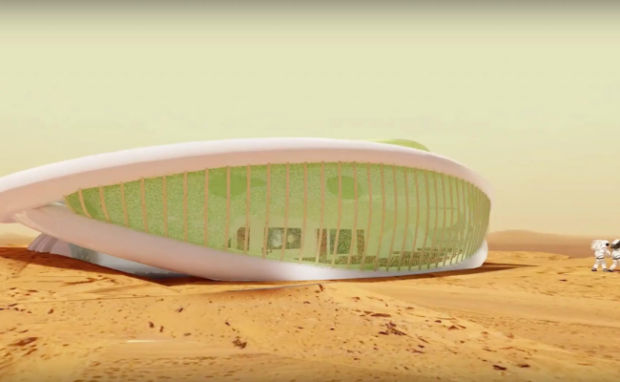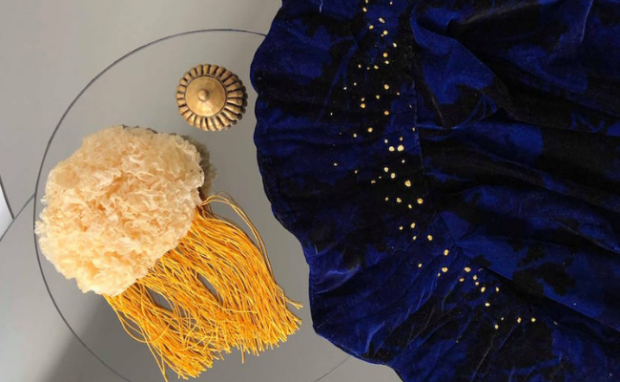Living in mushroom houses on the Moon and Mars
Titles for space research articles are getting stranger as NASA breaks the boundaries of what’s possible. The space agency is working with the Massachusetts Institute of Technology (MIT) Center for Bits and Atoms to build homes made from living organisms in space. Surprisingly, its researchers say it is stronger than concrete!
The most ambitious projects require unconventional methods to realize. Case in point, mushroom homes could be essential to living in outer space. It could facilitate establishing human settlements if we could “grow” shelter on the Moon and Mars. Soon, we may repurpose that technology on Earth to build sustainable housing.
This article will discuss how MIT plans to build mushroom houses on the Moon and Mars. Later, I will cover other fungus innovations, such as self-repairing clothes and biodegradable computer chips.
How do you build mushroom houses in space?

Photo Credit: newatlas.com
These fungus homes are a collaboration of American architecture firm Red House, NASA, and MIT. The project will involve the mycelium mushroom and waste biomass from Namibia’s infamous “encroacher bush.”
Christopher Maurer, Red House principal architect, explained to Euronews Next why the project will use mycelium. He said its unique properties “act like a glue to bind substrates [such as construction debris and plants] together.”
The waste biomass will come from Namibia’s infamous “encroacher bush” and will nurture the mycelium’s growth. However, it’s more difficult to grow in outer space “because there’s nothing for mycelium to grow on,” said Maurer. Here’s how Red House plans to grow mushroom homes in outers space:
- An unmanned Mars mission will carry a folded shelter. The latter will contain a sealed bag with dehydrated algae. Euronews Next said it would most likely be chaetomorpha or sea emerald and dormant mycelium.
- Then, a Martian rover would inject carbon dioxide, nitrogen, and water from Mars into the sealed bag to rehydrate the algae. Consequently, it will trigger a reaction that produces oxygen and nourishes the mycelium.
- The mycelium will grow and expand into its intended shape and fuse with the algae to form concrete biomass.
You may also like: MIT develops faster robot training method
“In a dream scenario, it could be erected in a matter of hours or even minutes if you had the right kind of pressure pumping into it. Then, creating the solid, dry biomaterial that becomes insulating would ideally take four weeks,” said the principal architect.
Maurer consulted NASA’s planetary protection experts to determine whether his technique could build mushroom homes. He said they replied, “They kind of looked at it and said it looks okay.”
Other interesting mushroom innovations

Photo Credit: fashionjournal.com.au
Researchers have been doing some incredible things with mushrooms. Aside from outer space homes, Newcastle University and Northumbria University scientists have tried turning fungi into clothing material.
They focused on the Ganoderma lucidum fungus known as “Lingzhi” or “Reishi.” They published their findings, stating, “Self-healing is possible with minimal intervention after a two-day recovery period.”
We already use mycelium-based materials in construction, textile manufacturing, and other industries. However, production usually kills chlamydospores, which help fungi regenerate.
That is why the researchers combined mycelium, proteins, chlamydospores, carbohydrates, and other nutrients in a liquid. It encouraged the growth of a “skin” that people can detach and dry.
The material repairs itself but is too thin and delicate for garments. Hence, the researchers recommended combining layers or plasticizing them in glycerol.
Meanwhile, Johannes Kepler University researchers turned mycelium into computer chips. They injected Reishi spores into moist beech wood shavings. Afterward, they covered the spores with polyethylene separator grids and stored them at 25 degrees Celsius.
The experts waited for the mushroom spores to grow a “skin layer.” Then, they removed the separator and peeled the fungus skin from the beech wood.
You may also like: NASA taps Austin firm to build Moon homes
The Kepler researchers subjected the layer through a drying and compression phase. Next, they applied physical vapor deposition of thin gold and copper layers on the skin.
In other words, they turned these solid metals into gases that solidified on the mushroom skin. Then, the researchers surgically removed it with a laser to create circuit pathways.
Their mushroom computer chips can turn into batteries, sensors, and a Bluetooth communication module. Also, you can safely deposit them into compost bins because they’re biodegradable.
Conclusion
Science and technology continue to baffle and amaze everyone as NASA plans to deploy mushroom homes on the Moon and Mars. The space agency claims it could be a practical method of establishing human settlements in outer space.
It mixes with biomass to produce a substance harder than concrete. As a result, it can be a foundation for human housing on the Red Planet and the Earth’s oldest satellite.
Space research has been on a roll this year due to its wondrous innovations. Learn more about those projects and other digital trends at Inquirer Tech.